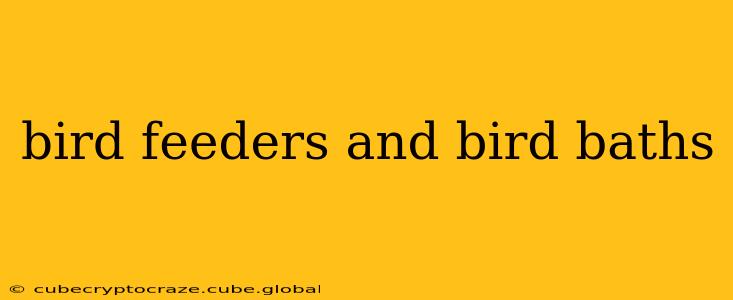Birds bring joy and vibrancy to any garden. Providing food and water sources through bird feeders and bird baths is a rewarding way to attract a diverse range of avian visitors and observe their fascinating behaviors up close. This comprehensive guide will delve into the world of bird feeders and bird baths, helping you create a haven for your feathered friends.
What are the different types of bird feeders?
There's a wide variety of bird feeders available, each designed to attract specific bird species based on their feeding preferences and physical capabilities. Tube feeders, for instance, are popular and dispense seeds through small holes, ideal for smaller birds like finches and chickadees. Hopper feeders offer a larger platform for various seeds and are often favored by larger birds like doves and cardinals. Suet feeders, filled with high-energy suet cakes, attract woodpeckers and other birds needing extra calories during colder months. Finally, platform feeders, offering an open tray, are accessible to many species, including ground-feeding birds. Choosing the right feeder depends on your local bird species and your personal preferences.
What are the best types of bird baths?
Just as with feeders, bird baths come in various designs to cater to different bird sizes and preferences. Shallow dishes with gently sloping sides make it easy for smaller birds to access water, while deeper baths with rocks or pebbles added provide both drinking and bathing options. Consider adding a gently dripping source, as moving water is particularly appealing to birds. Placement is crucial; position your bird bath in a visible, yet protected spot away from predators and direct sunlight. Regular cleaning is vital to prevent the spread of diseases.
How do I choose the best location for my bird feeder?
Strategic placement of your bird feeder is essential for maximizing its effectiveness and ensuring the safety of your avian visitors. Ideally, position your feeder at least 4-5 feet from any cover, such as shrubs or buildings, to prevent cats or other predators from ambushing your birds. Consider the direction of prevailing winds – a sheltered location is preferable. Maintaining visibility from a window for your own enjoyment is a great added bonus! Remember to clear away any fallen seeds or debris regularly to maintain cleanliness and hygiene.
How do I choose the best location for my bird bath?
Similar to feeders, bird bath placement is vital. Choose a location that's both visible and sheltered from extreme weather and potential predators. Avoid placing it in direct sunlight, which can cause the water to evaporate quickly and become unpleasantly warm. A slightly shaded spot is ideal. The proximity to shrubs or trees offers birds a safe escape route if needed. A small, shallow bird bath is perfect for smaller birds. Larger baths, however, can accommodate a greater variety of species.
What kind of birdseed should I use?
Selecting the right birdseed is crucial in attracting the birds you want to see. Sunflower seeds are a favorite among many species, offering high energy and nutritional value. Nyjer seeds are popular with finches, while cracked corn attracts larger ground-feeding birds. Avoid using mixes containing filler ingredients like milo or wheat, as these are often less attractive and may lead to wasted food. Consider offering a variety of seeds to cater to diverse species in your area.
How often should I clean my bird feeders and bird baths?
Regular cleaning of both bird feeders and bird baths is essential for maintaining bird health and hygiene. Clean your feeders at least once a week, or more frequently in warmer weather. Remove old or spoiled seed, and thoroughly wash the feeder with warm, soapy water. Rinse well and allow to dry completely before refilling. Bird baths require daily cleaning to remove debris and prevent the growth of bacteria and algae. Scrub the bath thoroughly and refill with fresh water.
How do I attract specific types of birds?
Attracting specific bird species often requires offering their preferred food sources. For example, suet feeders attract woodpeckers and nuthatches, while platform feeders are good for attracting larger birds like doves and jays. Offering mealworms can attract wrens and robins. Research the common birds in your region and discover their dietary preferences to create the most appealing bird feeding station.
By following these guidelines and adapting them to your specific needs and local birdlife, you can successfully attract a vibrant community of birds to your garden, providing a beautiful and enriching experience for both you and your feathered friends. Remember, observation and adaptation are key to creating the perfect bird-friendly haven.
